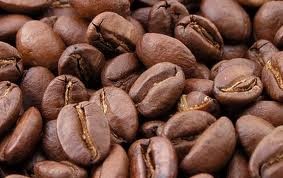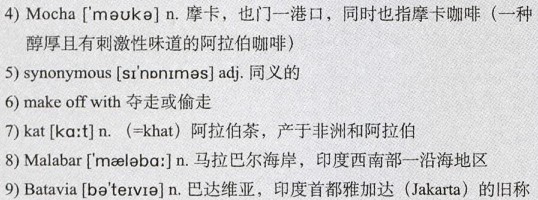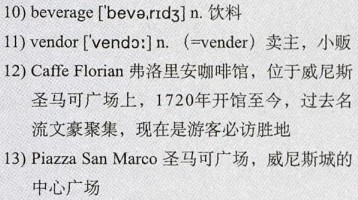文字难度:★★★
THE ORIGIN OF COFFEE 咖啡的起源
The story of how coffee growing and drinking spread around the world is one of the greatest and most romantic in history. It starts in the Horn of Africa, in Ethiopia, where the coffee tree probably originated in the province of 1)Kaffa. There are various fanciful but unlikely stories surrounding the discovery of coffee beans. One story has it that an Ethiopian 2)goatherd was amazed at the lively behaviour of his goats after chewing red coffee berries. What we know with more certainty is that the 3)succulent outer cherry flesh was eaten by slaves taken from present day Sudan into Yemen and Arabia, through the great port of its day, 4)Mocha, now 5)synonymous with coffee. Coffee was certainly being cultivated in Yemen by the 15th century and probably much earlier than that.
咖啡的种植和饮用在全世界广泛流传的经历可以说是历史上最神奇、最浪漫的故事之一。这段传奇从位于埃塞俄比亚的非洲之角(即索马里)开始,咖啡树最早可能就是在那里的喀法省出现的。关于咖啡豆是如何被发现,有各种各样离奇但不靠谱的传说。其中一个故事说的是一个埃塞俄比亚牧羊人惊讶地发现他的山羊吃了一些红色的咖啡浆果后行为变得异常活跃。然而我们能够比较肯定的是,当年奴隶通过当时昌盛的海港摩卡从今天的苏丹被卖到也门和阿拉伯地区时,他们都会吃这些咖啡果外层味甜汁多的果肉,而时至今日摩卡已成了咖啡的同义词。到了15世纪,也门肯定已经栽种有咖啡,说不定时间还要更早些。
 Mocha was also the main port for the one sea route to Mecca, and was the busiest place in the world at the time. But the Arabs had a strict policy not to export any fertile beans, so that coffee could not be cultivated anywhere else. The coffee bean is the seed of the coffee tree, but when stripped of its outer layers it becomes infertile. The race to 6)make off with some live coffee trees or beans was eventually won by the Dutch in 1616.
Mocha was also the main port for the one sea route to Mecca, and was the busiest place in the world at the time. But the Arabs had a strict policy not to export any fertile beans, so that coffee could not be cultivated anywhere else. The coffee bean is the seed of the coffee tree, but when stripped of its outer layers it becomes infertile. The race to 6)make off with some live coffee trees or beans was eventually won by the Dutch in 1616.
摩卡在当时也是前往圣地麦加的海上航线上的主要港口之一,也是当时世界是最繁忙的港口。但阿拉伯人有一个严格的规定,禁止出口所有能结果的豆类,因此咖啡未能在其他地方种植。咖啡豆是咖啡树的种子,但咖啡豆去壳后就不能结果了。最终,荷兰人于1616年赢得了偷取活咖啡树或咖啡豆的竞赛。
Initially, the authorities in Yemen actively encouraged coffee drinking as it was considered preferable to the extreme side effects of 7)Kat, a shrub whose buds and leaves were chewed as a stimulant. The first coffeehouses were opened in Mecca and were called “kaveh kanes”. They quickly spread throughout the Arab world and became successful places where chess was played, gossip was exchanged, and singing, dancing and music were enjoyed. They were luxuriously decorated and each had an individual character. Nothing quite like the coffeehouse had existed before: a place where society and business could be conducted in comfortable surroundings and where anyone could go, for the price of coffee.
也门当局一开始就积极鼓励人们饮用咖啡,因为相对于阿拉伯茶——一种果实和叶子被人们咀嚼来提神的灌木——强烈的副作用来说,咖啡要温和些。世界上的第一批咖啡馆在圣地麦加诞生,它们被叫作“kaveh kanes”。随后,咖啡馆迅速遍布阿拉伯地区,顾客盈门。它成了人们下棋、闲聊、欣赏歌舞和音乐的地方。咖啡馆的装修豪华,每家都各有特色。这是一种前所未有的场所:社交活动在这里进行,生意在这里成交;这里环境舒适,只需付上一杯咖啡的价钱,就人人都可以去。
The Arabian coffeehouses soon became centres of political activity and were suppressed. Coffee and coffeehouses were subsequently banned several times over the next few decades, but they kept reappearing. Eventually a solution was found when coffeehouses and coffee were taxed.
阿拉伯地区的咖啡馆很快成为政治活动的中心,因此遭到了查禁。在以后的几十年里,咖啡和咖啡馆屡次被禁,但却总是重新冒头。最终的解决办法是当局对咖啡馆和咖啡课税。
COFFEE COMES TO ASIA 咖啡来到亚洲
The Dutch were also growing coffee at 8)Malabar in India, and in 1699 took some to 9)Batavia in Java, in what is now Indonesia. Within a few years the Dutch colonies had become the main suppliers of coffee to Europe. Today Indonesia is the fourth largest exporter of coffee in the world.
荷兰人还在印度的马拉巴尔海岸种植咖啡,并于1699年带了一些到如今属于印尼爪哇的巴达维亚(雅加达的旧称)。几年后,荷兰在此的殖民地就成为欧洲咖啡的主要供应源。如今,印度尼西亚是世界上第四大咖啡出口国。
COFFEE COMES TO EUROPE 咖啡来到欧洲
Venetian traders first brought coffee to Europe in 1615. This was a period when the two other great hot 10)beverages also appeared in Europe. Hot chocolate was the first, brought by the Spanish from the Americas to Spain in 1528; and tea, which was first sold in Europe in 1610.
At first coffee was mainly sold by lemonade 11)vendors and was believed to have medicinal qualities. The first European coffeehouse opened in Venice in 1683, with the most famous, 12)Caffe Florian in 13)Piazza San Marco, opening in 1720. It is still open for business today.
威尼斯商人于1615年首次把咖啡带回欧洲。与此同时,另外两样很受欢迎的热饮料也先后在欧洲出现。先是由西班牙人在1528年从美洲带回去的热巧克力;然后是在1610年被引进欧洲的茶。
一开始,主要是卖柠檬水的小贩售卖咖啡,当时咖啡被认为是有药用效果的饮料。1683年,第一家欧洲咖啡馆在威尼斯开张,而最有名的弗洛里安咖啡馆于1720年在圣马可广场开张,至今仍在营业。
COFFEE COMES TO THE AMERICAS 咖啡来到美洲
The first reference to coffee being drunk in North America is from 1668 and, soon after, coffee houses were established in New York, Philadelphia, Boston and other towns. Both the New York Stock Exchange and the Bank of New York started in coffeehouses, in what is today the financial district known as Wall Street. It was in the 1720s that coffee first came to be cultivated in the Americas, through what is perhaps the most fascinating and romantic story in the history of coffee.
Gabriel Mathieu de Clieu was a French naval officer serving in 14)Martinique who in 1720, went to Paris on leave. With assistance and no little personal charm he acquired a coffee tree which he took with him on the ship back. The plant was kept in a glass case on deck to keep it warm and prevent damage from salt water. The journey was eventful, or at least Mr. Mathieu de Clieu’s journal of the voyage was. Pirates from Tunis threatened the ship, there was a violent storm and the plant had to be tied down. Our hero faced an enemy on board who was jealous and tried to 15)sabotage the plant. There was a violent struggle in which a branch was torn off, but the plant survived this horror. Then the ship was 16)becalmed and drinking water was rationed. De Clieu had his priorities right and gave most of his allowance of precious water to the coffee plant. It survived, as did he.
Finally, the ship arrived in Martinique and the coffee tree was replanted, where it was surrounded by a thorn hedge and watched over by slaves. It grew, and multiplied, and by 1726 the first harvest was ready. It is recorded that by 1777, there were between 18 and 19 million coffee trees on Martinique, and the model for a new cash crop that could be grown in the New World was in place.
在北美洲,咖啡的饮用被第一次提到是在1668年,很快,咖啡馆就在纽约、费城、波士顿及其他城市相继出现。纽约股票交易所和纽约银行诞生在位于当今金融街区的咖啡馆里,该街区即是如今赫赫有名的华尔街。咖啡首次在美洲种植是18世纪20年代,而这里发生了咖啡历史上最迷人的浪漫故事。
加布里埃尔·马蒂厄·德·克利是一名驻扎在马提尼克岛的法国海军军官,1720年,他请假去巴黎。靠着他人的帮助以及他过人的个人魅力,他弄到了一棵咖啡树,并把它带到了船上。为了给咖啡树保暖,并防止海水的损害,他把树安放在甲板上的一个玻璃箱里。旅程可谓惊险重重,至少马蒂厄·德·克利日记里是这么记载的。突尼斯的海盗威胁着船只的安全,船遇上了猛烈的风暴,咖啡树要被固定住才行。而在船上,我们的主人公还有一位心怀妒意的对手,试图毁坏咖啡树。争夺保卫之战异常激烈,树的一条枝干被折断了,但咖啡树最终逃过了一劫。之后,船因无风而停航,船上的饮用水实行统一定量分配。马蒂
厄·德·克利深明大义,把自己的大部分宝贵的水用来浇咖啡树。树活下来了,他也幸免于难。
最终,船到达马提尼克岛,咖啡树被种在了这里,树的周围竖起了带刺的篱笆,由奴隶看守。咖啡树繁衍生息,到1726年,人们终于迎来了第一次收获。据记载,到了1777年,马提尼克岛有一千八百到一千九百万株咖啡树。于是,在新大陆上种植摇钱树的模式也就形成了。
COFFEE TODAY 咖啡的今天
This new found “coffee culture” has started to spread to the rest of the world. To those countries with great coffee traditions of their own, such as Italy, Germany, and Scandinavia, new converts were introduced to the pleasures of good coffee. Today it is possible to find good coffee in every major city of the world, from London to Sydney to Tokyo; tomorrow the world will drink more and more importantly, better coffee.
这种新生的“咖啡文化”已开始传播至世界其他角落。除了像意大利、德国和斯堪的纳维亚半岛诸国这些有着各自丰富咖啡传统的国家,还有不少新的咖啡爱好者学会了享受优质咖啡。如今,不管是在伦敦、悉尼,还是东京,在世界各大城市,要找到好咖啡并不难。明天,这个世界将会喝越来越多的咖啡,更重要的是,咖啡的质量将越来越好。





